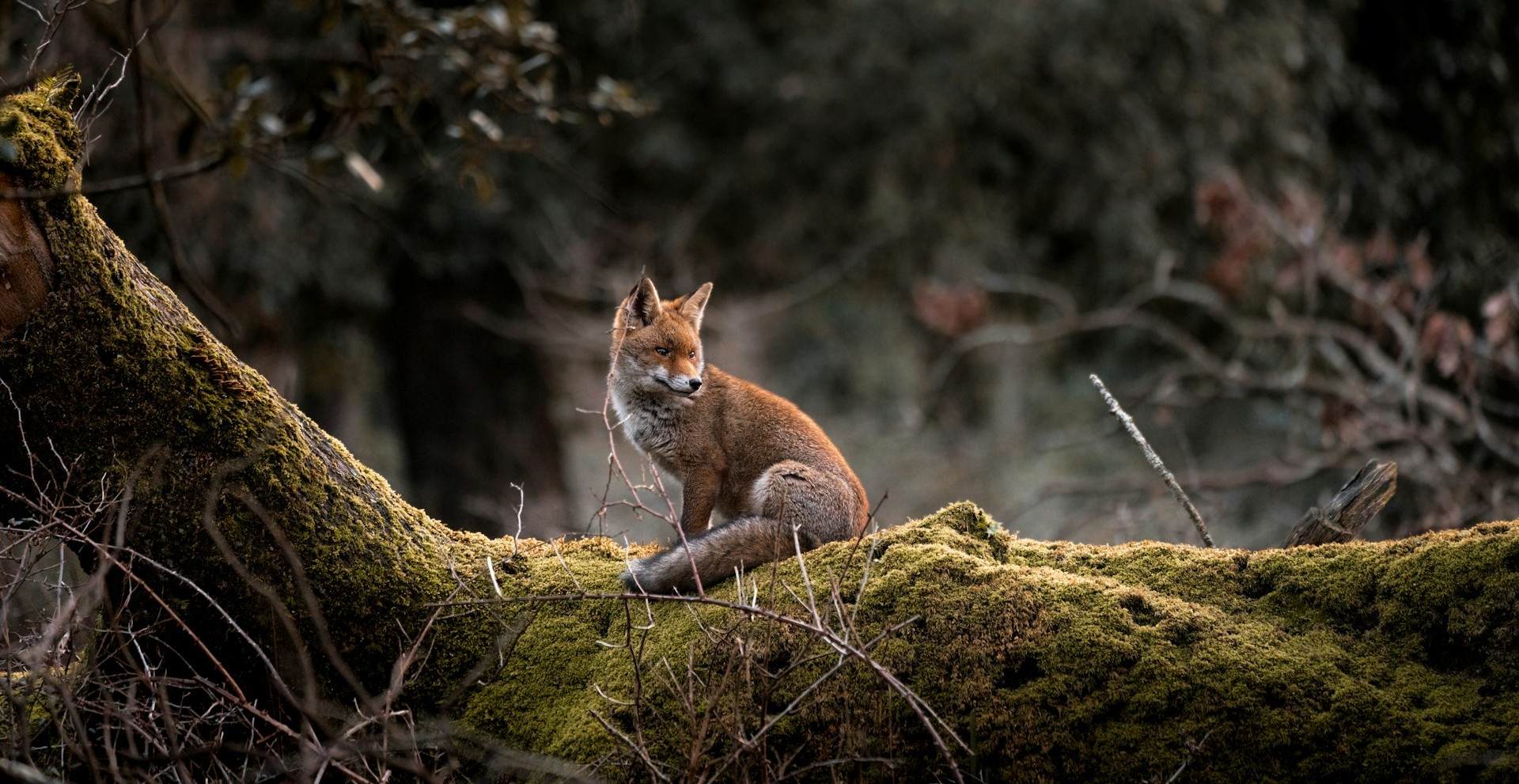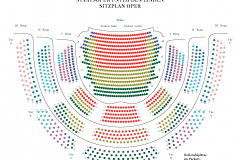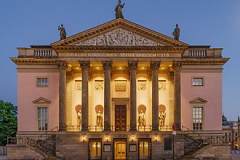The Cunning Little Vixen
Mo | Tu | We | Th | Fr | Sa | Su |
The Cunning Little Vixen
Opera in three acts (2025)
Music from Leoš Janáček
Text from Leoš Janáček nach der Novelle von Rudolf Těsnohlídek
Language: Czech, with German and English surtitles.
Recommended age: 14 years and older
With his poetic opera The Cunning Little Vixen, Leoš Janáček brought nothing less than the eternal cycle of becoming and passing to the stage. It tells the life story of the young, rebellious vixen Bystrouška, or Sharp Ears, who is captured by the forester and starts a revolution at his homestead before she succeeds in escaping. Back in the freedom of the forest, she founds a family with a fox and is then shot by a poacher. The seemingly so civilized human world looks wistfully at wild nature, which follows its own laws of life and love.
Inspired by an illustrated novella by Rudolf Těsnohlídek, for this opera, which premiered in 1924, Janáček created a highly sensual, impressionistic score that reflects the mutual interaction of humans and animals. This “Czech midsummer night’s dream” will be directed by Ted Huffman, making this his premiere at the Staatsoper: at the podium, the celebrated Janáček-expert Simon Rattle.
Synopsis
Act 1
In the forest, the animals and insects are playing and dancing. The forester enters and lies down against a tree for a nap. A curious vixen cub (often sung by a young girl), inquisitively chases a frog right into the lap of the surprised forester who forcibly takes the vixen home as a pet. Time passes (in the form of an orchestral interlude) and we see the vixen, now grown up into a young adult (and sung by a soprano) tied up in the forester's yard with the conservative old dachshund. Fed up with life in confinement, the vixen chews through her rope, attacks the rooster and hen, kills the other chickens, jumps over the fence and runs off to freedom.
Act 2
The vixen takes over a badger's home and kicks him out. At the inn, the parson, the forester, and the schoolmaster drink and talk about their mutual infatuation with the gypsy girl Terynka. The drunken schoolmaster leaves the inn and mistakes a sunflower behind which the vixen is hiding for Terynka, professing his devotion to her. The forester, also on his way home, sees the vixen and fires two shots at her, sending her running. Later, the vixen, coming into her adulthood, meets a charming boy fox, and they retire to the badger's home. An unexpected pregnancy and a forest full of gossipy creatures necessitate their marriage, which rounds out the act.
Act 3
The poacher Harašta is engaged to Terynka and is out hunting in preparation for their marriage. He sets a fox trap, which the numerous fox and vixen cubs mock. Harašta, watching from a distance, shoots and kills the vixen, sending her children running. At Harašta's wedding, the forester sees the vixen's fur, which Harašta gave to Terynka as a wedding present, and flees to the forest to reflect. He returns to the place where he met the vixen, and sits at the tree, grieving the loss of both the vixen and Terynka. His grief grows until, just as in the beginning of the opera, a frog unexpectedly jumps in his lap, the grandson of the one who did so in Act 1. This reassurance of the cycle of death bringing new life gives his heart a deep peace.
Program and cast
Conductor: Simon Rattle
Production: Ted Huffman
Set Design: Nadja Sofie Eller
Costumes: Astrid Klein
Chorus Rehearsal: Dani Juris
Dramaturgy: Elisabeth Kühne
Vixen Sharp-Ears: Vera-Lotte Boecker
Fox: Magdalena Kožená
Forester: Svatopluk Sem
Forester’s Wife, Owl: Natalia Skrycka
Schoolmaster, Mosquito: Florian Hoffmann, Stephan Rügamer
Parson, Badger: David Oštrek
Harašta: Carles Pachon
Dachshund: Sandra Laagus
Rooster: Anna Samuil
Mrs Pásek, Hen: Adriane Queiroz
Jay: Sonja Herranen
Chorus of the Staatsoper, Children’s Chorus of the Staatsoper, Staatskapelle Berlin
State Opera Unter den Linden
Staatsoper Unter den Linden is one of Berlin's most prestigious opera houses, with a rich history and significant cultural impact.
History:
The Staatsoper Unter den Linden was originally built between 1741 and 1743, under the direction of architect Georg Wenzeslaus von Knobelsdorff. It was commissioned by Frederick II of Prussia and was initially named the Königliche Oper (Royal Opera). The opera house has undergone several renovations and reconstructions, notably after World War II damage. It reopened in 1984, following a major renovation.
Construction:
The original design was characterized by its Baroque style, featuring an elegant façade and a grand entrance. The building was reconstructed in the 1950s and 1980s, maintaining its classical exterior while modernizing the interior. The façade features a classic portico with six Corinthian columns and a prominent central pediment.
Interior:
The interior is known for its opulent and classical design. The auditorium is renowned for its acoustics and grandeur, with luxurious velvet seats and elaborate decorations. The stage and seating areas have been updated to meet modern performance standards while preserving historical aesthetics.
Concerts and Performances:
The Staatsoper Unter den Linden hosts a variety of performances, including operas, orchestral concerts, and ballet. It is home to the Staatskapelle Berlin, one of Germany's leading orchestras. The opera house is celebrated for its high-quality productions and its role in Berlin’s vibrant cultural scene.
JOURNEY
The Staatsoper Unter den Linden has completely barrier-free access due to its excellent public transport connections.
ADDRESS: Unter den Linden 7; 10117 Berlin
SUBURBAN RAILWAY
S+U Friedrichstraße (S1, S2, S5, S7, S25, S75)
SUBWAY
Hausvogteiplatz (U2)
Museumsinsel (U5)
Stadtmitte (U2, U6)
Unter den Linden (U5, U6)
BUS
Staatsoper (100, 245, 300)
Unter den Linden/Friedrichstraße (100, 147, 245, 300, N6)
PARKING
Q-PARK parking garage Unter den Linden/Staatsoper
Bebelplatz, 10117 Berlin
There are five electric charging stations in the parking garage. Further information can be found here.
The underground car park on Bebelplatz offers disabled parking spaces and direct access to the opera house. On entering the car park between 5.30pm and 11.30pm, the maximum parking fee is €7. To use this tariff, enter your parking ticket in one of the pay machines and the message »Theatertarif« will appear on the display. Please note that it is not possible to use the tariff if you enter the car park before 5.30pm. so it will not be shown on the display. TIP: If you pay the theatre tariff at the pay machine before the event, you can avoid unnecessary waiting after the show.

 EN
EN DE
DE IT
IT FR
FR ES
ES RU
RU JP
JP RO
RO
 Seating plan
Seating plan 